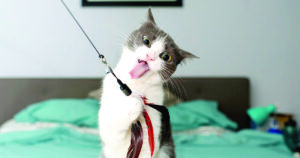By Dr. Beth Leermakers
When was the last time you saw a bumper sticker saying, “My cat is smarter than your honor student”? Probably never. We don’t tend to think of cats as being highly intelligent creatures.

Photo courtesy of Casey Elise Christopher/MyModernMet
How smart are cats? Are they smarter than dogs?
Answering these questions isn’t as easy as you’d think. Measuring feline intelligence is challenging because cats, who are not as eager to please as dogs, don’t tend to cooperate with researchers. Furthermore, cats and dogs have different intellectual strengths, so comparing them isn’t straightforward. Having said that, cats and dogs are both about as smart as human toddlers.
Here’s what we know about feline intelligence — and how you can evaluate your own cat’s smarts.
The average cat brain is about two inches long and weighs about one ounce. Although feline brains are smaller (absolutely and as a proportion of body mass) than dog brains and human brains, cat and human brains are similar in structure. Both feline and human brains have complex surface folding patterns that increase the relative surface area, improving cognition and overall brain function.
There are no standardized IQ (intelligence quotient) tests for cats or any animal, so scientists evaluate cognition — the way animals gather information, make decisions and then behave. Research about cat cognition reveals that cats are smarter than we think they are.
Cats have a sense of object permanence. This refers to the knowledge that objects continue to exist, even when we can’t see them. Cats know that an object that is hidden hasn’t disappeared. Human children understand this concept at about one to two years of age.
Cats have excellent short-term and long-term memory. Their memory allows them to accomplish a task (such as find a hidden toy), even if they are initially prevented from doing so. One study found that 50 cats remembered which bowl contained food, even after the cats were removed from the area for 15 minutes. Cats have social intelligence. They look for human cues and gestures and respond to people’s moods. For example, if you point to one of two bowls (signaling the cat to look at it), the cat will approach the correct bowl.
Some cat breeds are thought to be smarter than others:
• Abyssinian
• Siamese
• Persians
• Bengals
• Burmese
How Smart Is Your Cat?
Try these simple tests:
1. In a quiet room, show your cat that you have her favorite toy or treat. Then let your cat see you hiding the toy or treat under a box or cup. Does your cat search for the item under the box or cup? If so, she’s demonstrating a grasp of object permanence, and she’s at least as smart as a one-year-old child.
2. To evaluate your cat’s memory, hide the toy or treat as you did in the first test. Gently hold your cat so she can’t find her toy or treat right away. The first time, let your cat go after five seconds. Did she remember the item was there? Then hold your cat for 15 seconds, 30 seconds and then a minute.
3. Take a toy that moves (like a ball or wind-up toy) and show your cat how the toy moves. Then place the toy where it will travel behind or underneath a solid item. Does your cat correctly predict where the toy will reappear, or does she keep looking at the spot where it disappeared? If your cat correctly predicts where the toy will reappear and waits for it there, your cat is as smart as the average two-year-old child.
4. To evaluate whether your cat is tuned in to your emotions, take your cat into a room with a potentially frightening object it has never seen before, like a robotic vacuum.
Sit calmly on the floor with your cat, then make friends with the object, saying “what a nice vacuum” in a calm, friendly voice. Approach the object and touch it. If your cat is initially frightened of the object but calms down — and even approaches it — after you make friends with it, your cat is sensitive to your emotional cues and alters her behavior.
Other indicators of intelligence:
1. Your cat is reluctant to go into her carrier. Your cat remembers previous negative experiences (e.g., vet visits or long car rides) associated with the carrier. If so, this suggests that your cat has the long-term memory to recall previous negative experiences associated with the carrier (such as veterinary visits or long car rides).
2. Your cat scratches at a particular exterior door, wanting to go outside, even though you have never let her out through that door.
This behavior suggests that your cat has learned the purpose of that door by watching you and your family members.
3. Your cat opens a cabinet to get cat food or a catnip toy. This behavior demonstrates your cat’s problem-solving skills.
4. Your cat trained you to feed her at a particular time, by meowing or doing something else to get your attention. This indicates that your cat understands cause and effect (meowing or another behavior causes you to put food in the bowl!) and a grasp of the concept of time.
Whether your cat is a genius or relies on good looks and charm to get what she wants, she probably thinks she’s smarter than the dog. And she may be.
